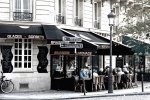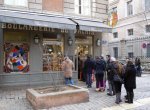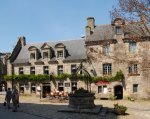picardie
REGION: HAUTS-DE-FRANCE
The Picardy region is in the north of France, not far from the English Channel; in fact, at its western edge it does have a hold on the Atlantic. It is flanked, to the north by Nord-Pas de Calais, to the east by Champagne-Ardenne, to the west by Haute-Normandie and to the south by the Ile de France. Today, it forms part of the new region of Hauts-de-France.
DEPARTMENTS (AND CAPITALS):
02 Aisne (Laon); 60 Oise (Beauvais); 80 Somme (Amiens)
Thiepval Franco-British memorial © ATOUT FRANCE/CRT Picardie/Sam Bellet
Less than an hour after leaving Calais, you slip seamlessly into the Département de la Somme, which with the départements of Oise and Aisne make up the region of Picardy. On the drive from the port, white roadside sculptures of figures fishing, shooting, riding horses, sand yachting and playing golf, remind you that this is a region renowned for its active outdoor life, its sporting culture and its seafood cuisine.
The capital of Picardy is Amiens, a magnificent testimony to the ability of people to recover from the devastation of war, and rebuild. This was the Gallo-Roman city of Samarobriva, and after the Roman occupation, continued to thrive as a major commercial centre. During the First World War, it served as an Allied communications centre, but during the Second World War, much of the city was destroyed by German bombing. As a result, much of the city is quite modern, but its old heart and the cathedral, somehow survived.
The whole of the region is also famed for its architecture, notably its cathedrals, its fortified churches and chateaux. And for the many beautiful gardens that seem to occur everywhere, from the glory of Valloires in the north to the almost single-handed creations in the Jardins de Viels-Maison on the very southern edge of Aisne: sixty-seven gardens in all, renowned for their quality as collections of rare plants, their ingenious design, their originality or quite simply the way they complement the buildings they surround.
This really is a land of contrasts from the towering chalk cliffs of Mer-les-Bains and Ault to the leafy valleys of the Thiérache. It is a region with the best reserves of game-filled ancient forest in northern Europe, its biggest tidal estuary, and the largest expanse of sand dunes. Wide skies or secretive marshlands, cosy villages nestling among rolling farmland and orchards, or the more open country of the Haute Somme; Picardy seems to have so much.
HIGHLIGHTS
St-Valéry-sur-Somme is a small settlement that
grew around a walled and gated medieval town, where in 1430 Jeanne d’Arc was
held prisoner en route from Le Crotoy to her trial at Rouen. More significantly
for the British, and almost 400 years earlier, it was from St-Valéry that
William the Conqueror set sail for England. Since then, the seafront houses
along the Quai Blavet have been built, and rather chic they look, too, brightly
painted and attractive with not a modern architectural blemish in sight. In
reality, there are two towns here, an upper town, with half-timbered houses
clustered around its flint church, and a lower town beside the port. St-Valéry
is the capital of the Vimeu region, and enjoys a lush and agreeable setting
overlooking the Bay of the Somme. If ‘location’ is everything, this lovely
village has it in spades.
From the seafront, the shimmering light plays tricks on the imagination, beguiling and at times thunderous, but always capable of producing something a little magical. Looking west, it is difficult to tell where the sea ends and the sky begins, the opaque luminescence inspiring painters and writers alike. From my restaurant table, I watch sauterelliers (local fishing boats), egrets and herons glide back and forth along the river, bathed momentarily in a few rays of sunshine that have slipped through a sliver in the cloudy sky’s armour.
Nowhere in St-Valéry, however, is far from the Baie de Somme, a huge and potentially intimidating place of sandy channels, mudflats and raised spread of La Mollière, were samphire is harvested by students for two less than two euros per kilo along with oreille de cochon, a fairly recent addition to culinary salads, although as a plant it has been around for hundreds of years.
On the other side of the bay, Le Crotoy seems lost in the vastness of the landscape. As at St Valéry, Jeanne d’Arc was briefly held captive here. Centuries later, this modest little town enjoys a vogue as a quiet holiday resort, though fishing is still the mainstay of its economy. Jules Verne stayed here, and spent a deal of time with Jacques-François Conseil, an inventor of submarine technology. From this liaison came the inspiration which led to Twenty Thousand Leagues under the Sea. But for me, Le Crotoy will always be synonymous with sea food, and in particular the simplest of dishes, mussels in white wine sauce. The mussels come from the bay, and that means they’re fresh; the same is true of the fish on sale along the seafront, though there are a few oddities among them, not least flancs de saumonette. An unusual specialty here is the lamb produced by sheep that grace the salt marshes, setting out at low tide to feed, and returning ahead of the tide to safer pastures. The flesh has a distinct and ready-salted flavour...if they grew potatoes out there, maybe we could have ready-salted crisps!
North of Le Crotoy lies the Parc Ornithologique du Marquenterre. Here, 3,000 hectares of pine forests, sand and mud flats are an irresistible draw for thousands of migratory birds. More than 240 species are logged here annually, and over 350 species recorded since the reserve opened in 1973. Birdwatchers in their thousands travel here each year from Britain, but it is as much a destination for less esoteric visitors who simply want to see white storks, spoonbills, egrets, herons, ducks, geese and swans in close up. Watch a short video (in French), here.
Further up the coast, the seaside resort of Fort-Mahon-Plage, is everything a seaside resort should be, except that it doesn’t have a pier. This is a fun place, bustling, bright, maybe a little brash, but a popular place with families and people who love what this breezy atmosphere has to offer. Sand yachting (char à voile) and sea kayaking, are just two pastimes that attract the adventurous, while cycling and walking will appeal equally to those for whom something a little more sedate is essential. But this area is renowned for its excellent international 71-par links golf course, the Golf de Belle Dune, one of twenty-three in Picardy, and one that is remarkably technical, with narrow fairways, and a reputation that attracts British people, often just for the day.
This is a region that has known untold grief and misery, ravaged by wars. But it was also the playground of kings, the happy hunting ground of off-duty monarchs, bishops and sycophants. It is a pastoral place, with exquisite countryside, gemlike villages with stories to tell, and a history that matches any in France.
© ATOUT FRANCE/CRT Picardie/Sam Bellet
REGIONAL TOURIST OFFICE
Comité Régional du Tourisme de Picardie
3 rue Vincent Auriol, 80011 AMIENS.
Tel: 03 22 22 33 66;
www.picardietourisme.com
Recent Articles
-
French Food and Drink - No BS Guide for lovers of Food, Wine, Liqueurs
Aug 28, 19 03:18 AM
Our guide to French food and drink for those who love traditional French food along with our no BS guide to understanding French wine and liqueurs
-
Things To Do In Carcassonne The Ultimate Tourist Guide
Aug 24, 19 06:26 PM
The ultimate tourist guide to things to do in Carcassonne when you visit this wonderful town in Aude France. Discover the places to go and see in Carcassone.
-
Lyon Old Town Guide to Vieux Lyon
Aug 18, 19 07:48 AM
Your complete guide to Lyon old town otherwise known as the Vieux Lyon. Don't miss this amazing part of the city if you're visiting Lyon in France.
-
18 French Villages You Must Visit Most Beautiful Villages in France
Aug 17, 19 06:31 AM
Our guide to the 18 most beautiful French villages you simply must visit. Loads of info, photos and facts in our ultimate villages in France tourist guide
-
What a Pissoir - The True Story of France's Unique Urinals
Aug 13, 19 03:47 PM
Is there anything more French than a pissoir? Sadly on the decline nevertheless the pissor is an endring image of the country. This is their story





